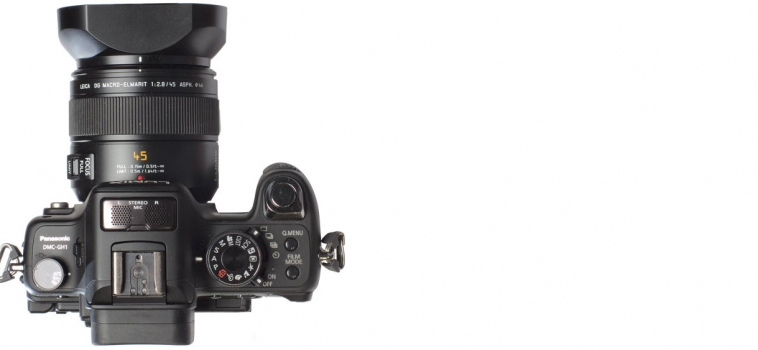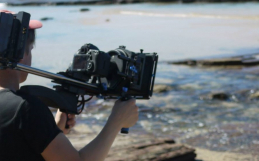I recently shot on the hacked Panasonic GH1 with the Lumix 14-140 lens while I was in New Zealand. This got me thinking about old cameras that get ignored. The image hasn’t gotten any worse but they are often sidelined by many when thinking about what camera to shoot on. They are also often amazing bargains. I’m going to add to this post as I go, so I’ll update it as I talk to my fellow shooters and try out some older cameras.
Panasonic’s first real DSLR: GH1
 Panasonic introduced the GH1 in 2009. It was picked up by many shooters including Philip Bloom, but it really came into its own when it was hacked and the limits of the internal codec were overcome.
Panasonic introduced the GH1 in 2009. It was picked up by many shooters including Philip Bloom, but it really came into its own when it was hacked and the limits of the internal codec were overcome.
You can pick ups a GH1 with a lens for around $200 on ebay these days. That’s an incredible deal. The camera may be a bit old but it still can produce fantastic images. Its super sharp and really easy to use.
 It uses the micro four thirds format, which is slightly smaller than super 35. Some of the criticisms leveled at the camera are the sensor size and the low light performance. Both issues can be improved substantially by adding a Metabones Speed Booster, a focal length reducer, that both increases the field of view of the lens being used and increases the amount of light hitting the sensor. There is also a benefit in sharpness but the GH1 really is sharp enough as it is.
It uses the micro four thirds format, which is slightly smaller than super 35. Some of the criticisms leveled at the camera are the sensor size and the low light performance. Both issues can be improved substantially by adding a Metabones Speed Booster, a focal length reducer, that both increases the field of view of the lens being used and increases the amount of light hitting the sensor. There is also a benefit in sharpness but the GH1 really is sharp enough as it is.
The other issue with the GH1 is the low bit rate. But the addition of the hack, created by Vitaly Kiselev, enables many control option as well as the increase in the bit rate. This enables a much nicer image and removes the muddy compression that originally affected the video coming out of the camera. It also means you don’t have to think about using an external recorder like you do on many other cameras.
You can find the information for the hack and PTool, the utility you need to apply it, here.
The main benefit of the Micro Four Thirds format is the flexibility to use almost any lens just by making use of simple adapters. The addition of the focal length reducers, like the one mentioned above, alleviate many of the issues people have with the sensor size being smaller than other formats, so it becomes an incredibly versatile camera.
If you are looking for a cheep way into shooting the GH1 or GH2 are great options and the online community for them is huge and helpful.
Cape Palliser Lighthouse. Shot on Panasonic GH1
Kosciuszko National Park. Shot on the GH1
The First of the post DSLR Big Chip Cameras: AF100
 Another great 2nd hand option is the Panasonic AF100. I have been using one since they first came out in 2011. Since then so many new cameras have come along. The Af100 has its issues just as any camera does, you can read about them here. But what it also has is a fantastic range of features, professional inputs like XLR, great size and weight, as well as the best lens mount around, the Mirco four thirds mount (m43).
Another great 2nd hand option is the Panasonic AF100. I have been using one since they first came out in 2011. Since then so many new cameras have come along. The Af100 has its issues just as any camera does, you can read about them here. But what it also has is a fantastic range of features, professional inputs like XLR, great size and weight, as well as the best lens mount around, the Mirco four thirds mount (m43).
The M43 mount allows you to mount almost any lens to the camera from super cheep old stills lenses to big cine glass with the use of simple adapters, including focal length reducers like the Metabones Speed booster mentioned in the GH1 section. And you can find them cameras cheap 2nd hand. And i mean Cheap!
I recently picked one up for $1200 au with 3 batteries and only 150 hours use on it. It’s still a great camera and is regularly put to professional use.
Again there is a fantastic community for the camera with loads of positive people. But most importantly it’s a complete package, add a lens and your good to go. No need for external recorders, audio recorders or any crazy rigging.
The AF100 can be a bit fiddly to get the best from. It can have harsh highlights and noisy black if you’re not careful. To get the best out of the AF100 I recommend black balance at the start of every shoot. Make it part of your set up routine. This helps reduce the noise in the image. I adjust my color balance for the shot and black balance straight after each time.
Also the gamma settings have a dramatic effect on noise. I found Cine D to be a bit noisy for my tastes. Bpress and Cine V are the two gammas I use. The native ISO on the AF100 is 400 ISO so if you can, stay there. Anything over, you introduce some noise, though 800 & sometimes 1600 are not to bad. I only use 200 if I want to knock back some light as it marginally reduces DR.
Primarily though you just need to make sure you are getting enough light. You should not be getting much noise if the image is exposed correctly. With the built-in wave form monitor, zebras and vector scope, you have all the tools you need to nail exposure.
Highlights are simply a case of keeping your eye out for them and managing your exposure to get the best from the image. the Cine V gamma setting helps here also.
My general AF100 Settings are:
Detail : -2
V Detail : -2
Coring : -4
Chroma Level : -4
DRS : 1 (this can introduce a wee bit of noise so be careful with this)
Gamma : Cine V
Matrix : Norm 2
Skin DTL : Off
Anything not mentioned is set to 0 or off.
City Morning. Shot on the AF100
Blue Mountains. Shot on the AF100
I’ll talk about the FS100, the F900 and other cameras that are super cheep and available and totally worth shooting with.
Talk soon!! 🙂







Why hello. I started a video production company about a year ago, and have been filming with a canon t3i, and a canon vixia HF S21. The Vixia was great when I got it five years ago, but since I use it as a stationary camera and the T3i as a B-Roll camera. I notice it can’t really hold up to the quality. So I was looking for a new camera and the Panasonic AG-AF100A, really caught my eye (especially since it’s $1500). My question is, will this camera still hold up today? I know it’s from 2011, is it better to get a newer camera? I shoot a little bit of everything (Plays, music videos, live events, weddings) Would you recommend this camera? Is it really complicated to use? Is the noise really bad, or can you remove in post? Thank you for your time!